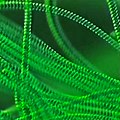File:Cyanobacteria.jpg

Original file (956 × 956 pixels, file size: 147 KB, MIME type: image/jpeg)
| This is a file from the Wikimedia Commons. Information from its description page there is shown below. Commons is a freely licensed media file repository. You can help. |
Summary
| DescriptionCyanobacteria.jpg |
Deutsch: Cyanobacteria
Die Bezeichnung Alge (lat. alga = „Seegras“, „Tang“) wird auf verschiedene eukaryotische Lebewesen angewendet, die im Wasser leben und Photosynthese betreiben. Dazu gehören auch zahlreiche photosynthetische Protisten. Algen stellen keine monophyletische Verwandtschaftsgruppe im Sinne der biologischen Systematik dar. Gleichwohl wird die Bezeichnung „Algen“ auch in der Biologie für einen Sammelbegriff verwendet. Aufgrund von äußerlichen Ähnlichkeiten wurden Cyanobakterien bis 1925 als „Blaualgen“ bezeichnet. Als Bakterien gehören sie jedoch zu den Prokaryoten und sind somit keine Algen. Sie sind Gegenstand der Bakteriologie, werden aber als historisches Relikt teilweise noch von der Botanik mit behandelt. Zur Bezeichnung der Algenkunde werden zwei gleichbedeutende Fremdwörter verwendet: Algologie oder seltener Phykologie (griechisch φῦκος phykos „Tang“). Unter Eukaryoten oder Eukaryonten werden alle Lebewesen zusammengefasst, deren Zellen einen Zellkern besitzen. Neben den Bakterien und Archaeen (gemeinsam Prokaryoten genannt) sind die Eukaryoten eine der drei Domänen in der Systematik der Lebewesen. Prokaryoten (Prokaryota) oder Prokaryonten (Prokaryonta) sind zelluläre Lebewesen, die keinen Zellkern besitzen. Ihr Zelltyp wird als Protocyte bezeichnet. Bakterien und Archaeen sind Prokaryoten. Der Name bezieht sich auf die Kernlosigkeit (altgriechisch πρό pró „vor“, „vorher“; κάρυον káryon „Nuss“ oder „Kern“). Die Bezeichnung Prokarya wird seltener verwendet; die Bezeichnung Monera ist veraltet. Die Einteilung von Lebewesen in Prokaryoten und Eukaryoten wurde erstmals von Edouard Chatton für Protisten deutlich herausgestellt und 1925 veröffentlicht. Die neuere Einteilung der zellulären Lebewesen in drei Domänen entspricht der Aufteilung der Prokaryoten in zwei Domänen: Bakterien und Archaeen. Die dritte Domäne sind die Eukaryoten. Die Helix (έλιξ Plural Helices oder Helizes), auch Schraube, Schraubenlinie, zylindrische Spirale oder Wendel genannt, ist eine Kurve, die sich mit konstanter Steigung um den Mantel eines Zylinders windet. Windungsrichtung Die Benennung der Windungsrichtung (Helizität) folgt der Rechte-Faust-Regel, die Helix ist rechtsgängig, wenn sie sich im Uhrzeigersinn windet (in der Richtung gesehen, in der sie sich vom Betrachter entfernt), andernfalls linksgängig. In der Botanik werden als rechtsgängige Helix wachsende Pflanzen linkswindend genannt, weil sie von oben betrachtet gegen den Uhrzeigersinn drehend nach oben wachsen.English: Cyanobacteria
Prokaryotes (Prokaryota) or prokaryotes (Prokaryonta) are cellular organisms that do not have a nucleus. Your cell type is called a protocyte. Bacteria and archaea are prokaryotes. The name refers to the seedlessness (ancient Greek πρό pró "before", "before"; κάρυον káryon "nut" or "core"). The term prokarya is used less often; the name Monera is out of date. The division of living beings into prokaryotes and eukaryotes was first clearly emphasized for protists by Edouard Chatton and published in 1925. The more recent division of cellular organisms into three domains corresponds to the division of prokaryotes into two domains: bacteria and archaea. The third domain are the eukaryotes. The helix (έλιξ plural helices or helices), also called screw, helix, cylindrical spiral or helix, is a curve that winds around the jacket of a cylinder with a constant pitch. Winding direction The naming of the winding direction (helicity) follows the right-hand rule, the helix is right-handed if it winds clockwise (seen in the direction in which it moves away from the viewer), otherwise left-handed. In botany, plants growing as right-handed helixes are called left-winding, because viewed from above, they grow counterclockwise upwards. |
| Date | |
| Source | https://www.flickr.com/photos/hinkelstone/23974806839/ |
| Author | quapan |
Licensing
- You are free:
- to share – to copy, distribute and transmit the work
- to remix – to adapt the work
- Under the following conditions:
- attribution – You must give appropriate credit, provide a link to the license, and indicate if changes were made. You may do so in any reasonable manner, but not in any way that suggests the licensor endorses you or your use.
| This image was originally posted to Flickr by quapan at https://flickr.com/photos/9361468@N05/23974806839. It was reviewed on 19 January 2021 by FlickreviewR 2 and was confirmed to be licensed under the terms of the cc-by-2.0. |
19 January 2021
Captions
Items portrayed in this file
depicts
some value
4 January 2016
image/jpeg
1fa33dd98561d1c93c74efc8e718bb94fcb0df46
150,821 byte
956 pixel
956 pixel
File history
Click on a date/time to view the file as it appeared at that time.
| Date/Time | Thumbnail | Dimensions | User | Comment | |
|---|---|---|---|---|---|
| current | 07:10, 19 January 2021 |  | 956 × 956 (147 KB) | Epipelagic | Uploaded a work by quapan from https://www.flickr.com/photos/hinkelstone/23974806839/ with UploadWizard |
File usage
The following 4 pages use this file:
Global file usage
The following other wikis use this file:
- Usage on de.wikipedia.org
- Usage on he.wikipedia.org
- Usage on meta.wikimedia.org
- Usage on www.wikidata.org
Metadata
This file contains additional information, probably added from the digital camera or scanner used to create or digitize it.
If the file has been modified from its original state, some details may not fully reflect the modified file.
| Orientation | Normal |
|---|---|
| Horizontal resolution | 72 dpi |
| Vertical resolution | 72 dpi |
| Software used | Adobe Photoshop CC (Windows) |
| File change date and time | 15:57, 9 January 2016 |
| Color space | sRGB |
| Date and time of digitizing | 02:26, 4 January 2016 |
| Date metadata was last modified | 16:57, 9 January 2016 |
| Unique ID of original document | xmp.did:4ba17c04-987b-e044-af27-7e3a12821f22 |
